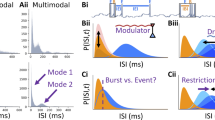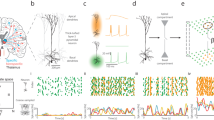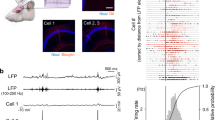Abstract
Neurons deep in cortex interact with the environment extremely indirectly; the spikes they receive and produce are pre- and post-processed by millions of other neurons. This paper proposes two information-theoretic constraints guiding the production of spikes, that help ensure bursting activity deep in cortex relates meaningfully to events in the environment. First, neurons should emphasize selective responses with bursts. Second, neurons should propagate selective inputs by burst-firing in response to them. We show the constraints are necessary for bursts to dominate information-transfer within cortex, thereby providing a substrate allowing neurons to distribute credit amongst themselves. Finally, since synaptic plasticity degrades the ability of neurons to burst selectively, we argue that homeostatic regulation of synaptic weights is necessary, and that it is best performed offline during sleep.







Similar content being viewed by others
Notes
We use the term “burst” loosely to indicate many spikes emitted in a short time.
In this paper, where we consider effective information generated by a single neuron and the mechanism is known, the \(do\)-calculus is redundant. We retain the notation to maintain consistency with prior and future work, where applying causal interventions is necessary.
We use the uniform distribution since, as shown in Eq. (3), it precisely captures the fraction of inputs causing an output.
We do not propose a rate code in the sense that only firing rates are meaningful. Rather, we suggest that firing rates have a specific, standardized meaning. Additional information can be encoded in the precise timing of spikes.
References
Abbott L, Nelson S (2000) Synaptic plasticity: taming the beast. Nat Neurosci 3:1178–1183
Attwell D, Laughlin SB (2001) An energy budget for signaling in the grey matter of the brain. J Cereb Blood Flow Metab 21(10):1133–45
Balduzzi D, Ortega PA, Besserve M, Metabolic cost as an organizing principle for cooperative learning. Under review. http://xxx.lanl.gov/abs/1202.4482
Balduzzi D, Tononi G (2008) Integrated Information in Discrete Dynamical Systems: Motivation and Theoretical Framework. PLoS Comput Biol 4(6):e1000–1091. doi:10.1371/journal.pcbi.1000091
Balduzzi D, Tononi G (2009) Qualia: the geometry of integrated information. PLoS Comput Biol 5(8):e1000–e1462. doi:10.1371/journal.pcbi.1000462
Beggs JM, Plenz D (2003) Neuronal avalanches in neocortical circuits. J Neurosci 23(35):11167–11177
Bhatt DH, Zhang S, Gan WB (2009) Dendritic spine dynamics. Annu Rev Physiol 71:261–282
Caporale N, Dan Y (2008) Spike timing-dependent plasticity: a Hebbian learning rule. Annu Rev Neurosci 31:25–46
Chklovskii DB, Schikorski T, Stevens CF (2002) Wiring optimization in cortical circuits. Neuron 34(3):341–347
Cover TM, Thomas JA (2006) Elements of information theory. Wiley, Hoboken
Czarnecki A, Birtoli B, Ulrich D (2007) Cellular mechanisms of burst firing-mediated long-term depression in rat neocortical pyramidal cells. J Physiol 578(2):471–479
Dan Y, Poo MM (2006) Spike timing-dependent plasticity: from synapse to perception. Physiol Rev 86(3):1033–1048
Deneve S (2008) Bayesian spiking neurons I: inference. Neural Comput 20(1):91–117
Dennett DC (2009) Darwin’s “strange inversion of reasoning”. Proc Natl Acad Sci USA 106(Suppl 1):10061–10065
Hebb DO (1949) Organization of behavior: a neuropsychological theory. Wiley, Hoboken
Huber R, Ghilardi M, Massimini M, Tononi G (2004) Local sleep and learning. Nature 430:78–81
Izhikevich E (2007) Solving the distal reward problem through linkage of STDP and dopamine signaling. Cerebral Cortex 17:2443–2452
Lee TS, Mumford D (2003) Hierarchical Bayesian inference in the visual cortex. J Opt Soc Am A 20:1434–1448
Legenstein R, Pecevski D, Maass W (2008) A learning theory for reward-modulated spike-timing-dependent plasticity with application to biofeedback. PLoS Comput Biol 4(10):e1000–e1180 doi:10.1371/journal.pcbi.1000180
Ma WJ, Beck JM, Latham PE, Pouget A (2006) Bayesian inference with probabilistic population codes. Nat Neurosc 9(11):1432–1438
Markram H, Lübke J, Frotscher M, Sakmann B (1997) Regulation of synaptic efficacy by coincidence of postsynaptic aps and epsps. Science 275(5297):213–215
Olshausen BA, Field DJ (2004) Sparse coding of sensory inputs. Curr Opin Neurobiol 14(4):481–487
Pawlak V, Wickens JR, Kirkwood A, Kerr JND (2010) Timing is not everything: neuromodulation opens the STDP gate. Front Syn Neurosci 2:146
Pearl J (2000) Causality: models, reasoning and inference. Cambridge University Press, Cambridge
Plenz D, Thiagarajan TC (2007) The organizing principles of neuronal avalanches: cell assemblies in the cortex? Trends Neurosci 30(3):101–110
Quiroga RQ, Reddy L, Koch C, Fried I (2005) Invariant visual representation by single neurons in the human brain. Nature 435:1102–1107
Rao RP, Sejnowski TJ (2001) Spike-timing-dependent Hebbian plasticity as temporal difference learning. Neural Comput 13(10):2221–2237
Rao RPN (2004) Bayesian computation in recurrent neural circuits. Neural Comput 16(1):1–38
Rolls ET, Tovee MJ (1995) Sparseness of the neuronal representation of stimuli in the primate temporal visual cortex. J Neurophysiol 73(2):713–726
Selfridge OG (1958) Pandemonium: a paradigm for learning. In: Mechanisation of thought processes: Proceedings of a Symposium Held at the National Physics Laboratory
Seung HS (2003) Learning in spiking neural networks by reinforcement of stochastic synaptic transmission. Neuron 40:1063–1073
Song S, Abbott LF (2001) Cortical development and remapping through spike timing-dependent plasticity. Neuron 32:339–350
Song S, Miller KD, Abbott LF (2000) Competitive Hebbian learning through spike-timing-dependent synaptic plasticity. Nat Neurosci 3(9):919–926
Steriade M (2001) The intact and sliced brain. MIT Press, Cambridge
Tononi G, Cirelli C (2001) Some considerations on sleep and neural plasticity. Arch Ital Biol 139(3):221–241
Tononi G, Cirelli C (2003) Sleep and synaptic homeostasis: a hypothesis. Brain Res Bull 62:143–150
Tononi G, Cirelli C, Pompeiano M (1995) Changes in gene expression during the sleep-waking cycle: a new view of activating systems. Arch Ital Biol 134(1):21–37
Tononi G, Edelman G, Sporns O (1998) Complexity and coherency: integrating information in the brain. Trends Cog Sci 2(12):474–484
Vyazovskiy VV, Cirelli C, Pfister-Genskow M, Faraguna U, Tononi G (2008) Molecular and electrophysiological evidence for net synaptic potentiation in wake and depression in sleep. Nat Neurosci 11(2):200–208
Vyazovskiy VV, Olcese U, Lazimy Y, Faraguna U, Esser SK, Williams JC, Cirelli C, Tononi G (2009) Cortical firing and sleep homeostasis. Neuron 63(6):865–878
Wilson MA, McNaughton BL (1994) Reactivation of hippocampal ensemble memories during sleep. Science 265(5172):676–679
Xu W, Morishita W, Buckmaster PS, Pang ZP, Malenka RC, Südhof TC (2012) Distinct neuronal coding schemes in memory revealed by selective erasure of fast synchronous synaptic transmission. Neuron 73(5):990–1001
Acknowledgments
We thank Michel Besserve for useful comments and Theorem 1. Supported in part by NIH Director’s Pioneer Award and Conte Center National Institute of Mental Health (P20MH077967) to GT, and by Defense Advanced Research Projects Agency, Defense Sciences Office (DSO), Program: Systems of Neuromorphic Adaptive Plastic Scalable Electronics (SyNAPSE).
Author information
Authors and Affiliations
Corresponding author
Appendices
Appendix 1: Proof of Theorem 2
Given distribution p(x) on X, let \(H(p)=-\sum _{x\in X}p(x)\cdot \log p(x)\) denote the entropy.
Theorem 2
Let \(p_1(y|x)\) and \(p_2(z|y)\) be Markov matrices on finite sets \(X\), \(Y\) and \(Z\). Let \(p_{12}(z|x)=\sum _{y\in Y}p_1(y|x)\cdot p_2(z|y)\) denote the composite channel. Then
Proof
As usual, \(p_1(y):=\sum _{x\in X}p_1(y|do(x))\cdot p_{\text{ unif}}(x)\) and \(p_{12}(z):=\sum _{x\in X}p_{12}(z|do(x))\cdot p_{\text{ unif}}(x)\). The actual repertoire is
Observe that
Combining Eq. (8) and (9) obtains
It is easy to check that \(c(y|z)\) induces a probability distribution on \(Y\) so that, by convexity of relative entropy Cover and Thomas (2006),
\(\square \)
Appendix 2: Effective information for Fig. 3
Effective information for the two detectors can be computed by exhaustively perturbing each with all possible configurations. However, since we understand their mechanisms, it is easy to replace exhaustive perturbation of the elements with combinatorics. First, since we have imposed the condition that every configuration contains 4 distinct dots in the \(8\times 8\) grid, it follows that the number of potential input patterns is \(635,376={{8\times 8}\atopwithdelims (){4}}\).
Effective information for the vertical rectangle: \(n_2\). The number of configurations fitting inside a vertical rectangle of width 7 is computed as follows. 4 dots can fit inside a rectangle of width 7 in \({8\times 7}\atopwithdelims ()4\) ways. Excluding configurations that fit inside a smaller rectangle of width 6, we find that there are \({8\times 7\atopwithdelims (){4}} -2{8\times 6\atopwithdelims (){4}} +{8\times 5\atopwithdelims (){4}}\) configurations that fit inside a rectangle of width 7, but not a rectangle of width 6 (we add \({8\times 5}\atopwithdelims (){4}\) to compensate for double counting). Finally, there are two ways a rectangle of width 7 can fit inside the grid, so there are \(139,040=2\left[{8\times 7\atopwithdelims (){4}} -2{8\times 6 \atopwithdelims (){4}} +{8\times 5 \atopwithdelims (){4}}\right]\) configurations that fit only inside a 7 pixel wide rectangle. Effective information is 2.2 bits.
Effective information for the horizontal rectangle: \(n_1\). The computation is similar to that above. There are \({{8\times 2}\atopwithdelims (){4}}-2{{8}\atopwithdelims (){4}}\) ways a configuration of 4 dots can fit inside a rectangle of height 2, without fitting inside a smaller rectangle of height 1. There are 7 different ways a rectangle of height 2 can be placed inside the grid, so there are \(11,760=7\left[{8\times 2\atopwithdelims (){4}}-2{8\atopwithdelims (){4}}\right]\) configurations only fit a 2 pixel high rectangle. Effective information is \(5.8\) bits.
Appendix 3: Applying Theorem 2 to Figs. 4 and 5
We apply equation
to the three cases in turn.
AND-gates.
Distribution \(c(y|z)\) is concentrated on \(y=11\). The channel \(n_1=AND^2\) decomposes into two AND-gates, generating 2 bits of information each. The only input on the bottom layer that causes a spike on the top layer is 1111.
OR-gates.
The distribution \(c(y|z)\) points to three potential causes: 01, 10, and 11, and is therefore less concentrated than in the case of an AND-gate. Moreover, each of these three potential inputs is less informative than in the preceding case.
The set of potential inputs on the bottom layer that cause a spike on the top layer includes everything except 0000.
Finally, note that in this case the upper-bound is very loose.
NOR-gates.
As for the AND-hierarchy, distribution \(c(y|z)\) is concentrated. However, it points to input \(00\), for which NOR-gates are uninformative.
The nine potential inputs causing output 1 on the top layer are \(\{0101, 1001, 0110, 1010, 1011, 0111, 1101, 1110, 1111\}\).
Rights and permissions
About this article
Cite this article
Balduzzi, D., Tononi, G. What can neurons do for their brain? Communicate selectivity with bursts. Theory Biosci. 132, 27–39 (2013). https://doi.org/10.1007/s12064-012-0165-0
Received:
Accepted:
Published:
Issue Date:
DOI: https://doi.org/10.1007/s12064-012-0165-0




